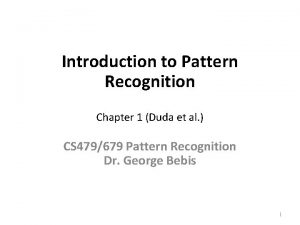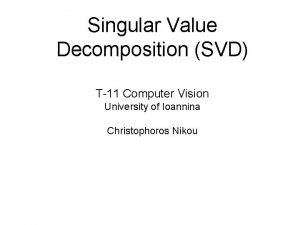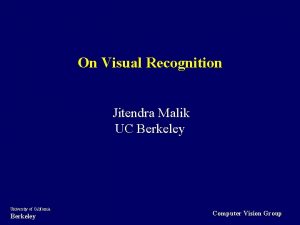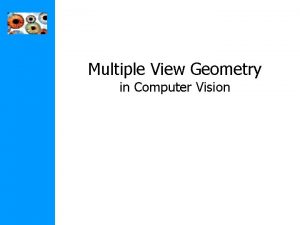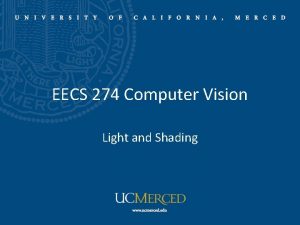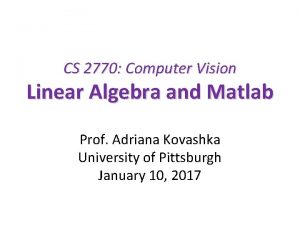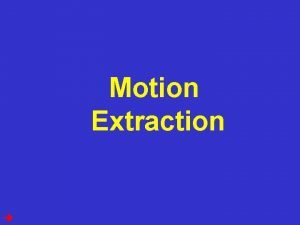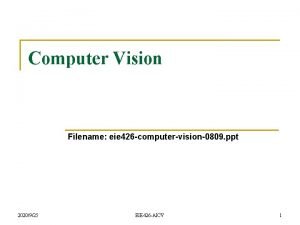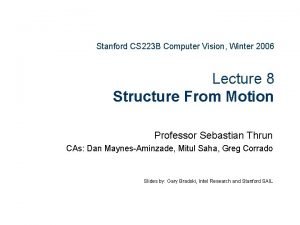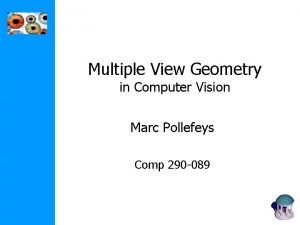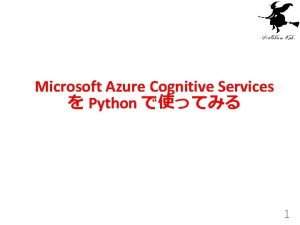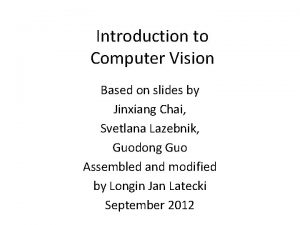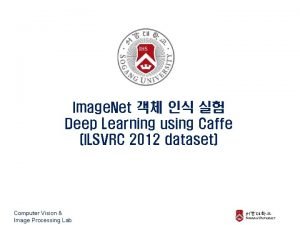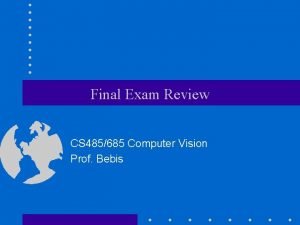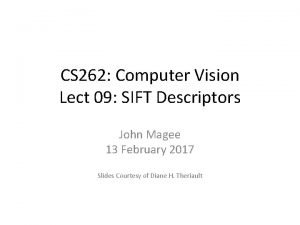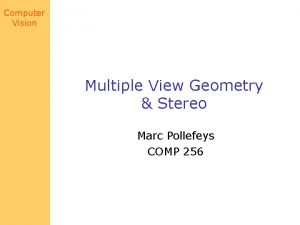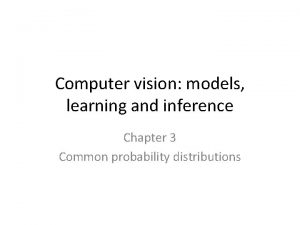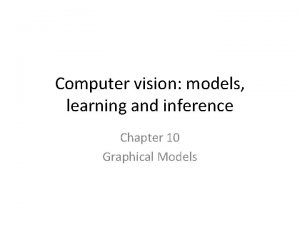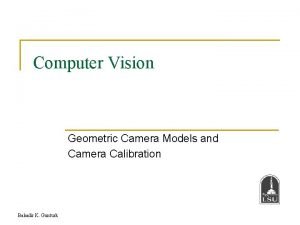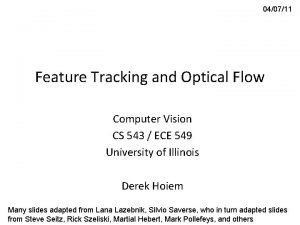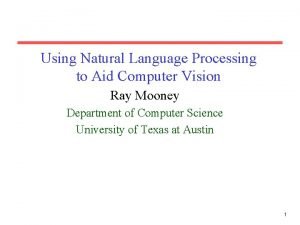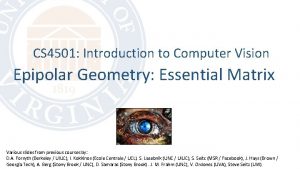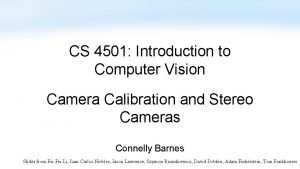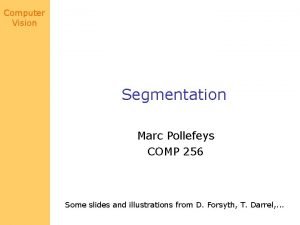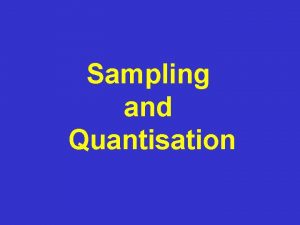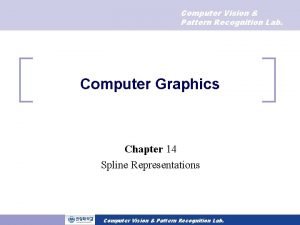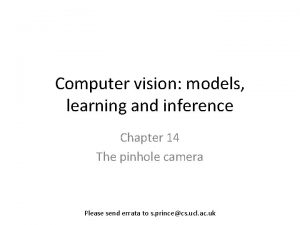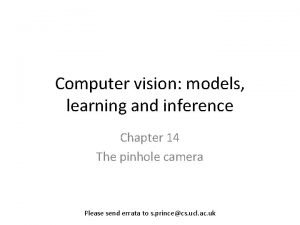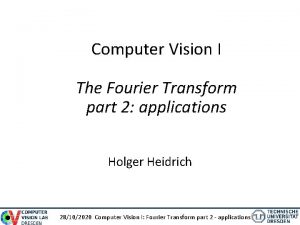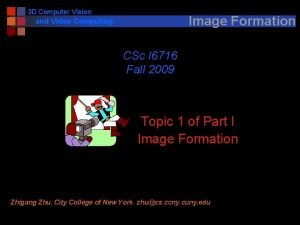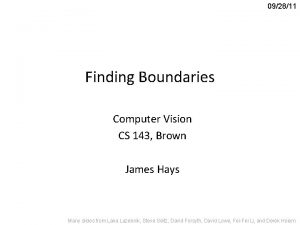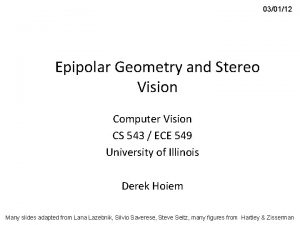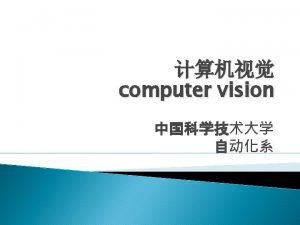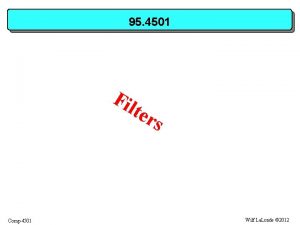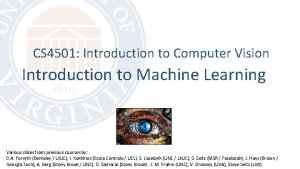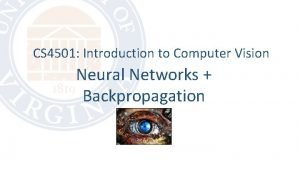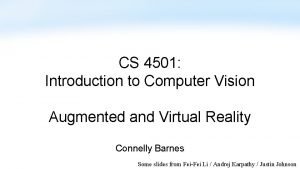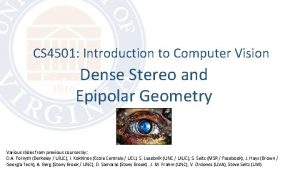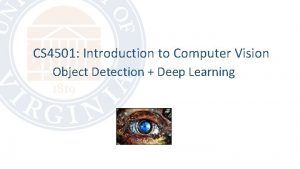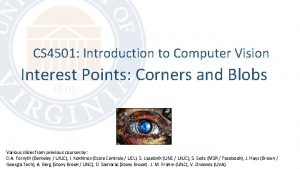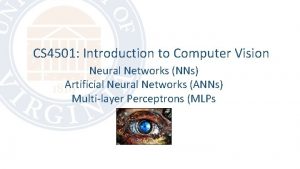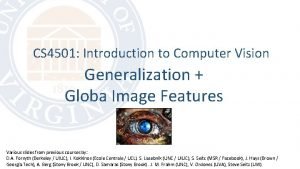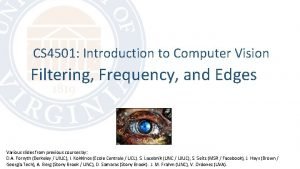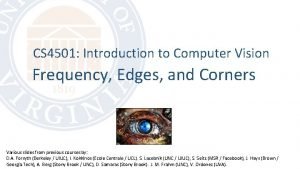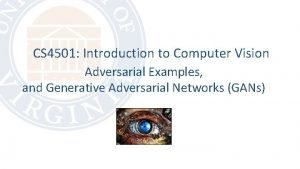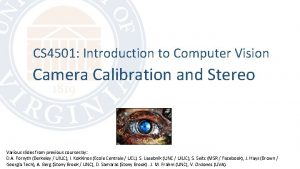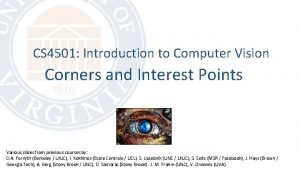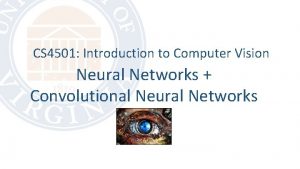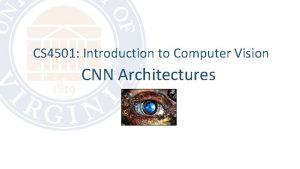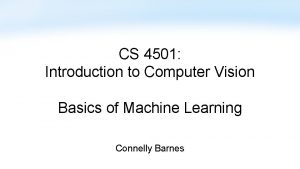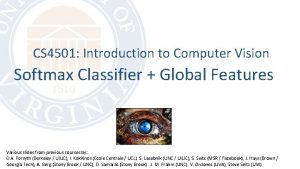CS 4501 Introduction to Computer Vision Video Recognition














































- Slides: 46

CS 4501: Introduction to Computer Vision Video Recognition / Optical Flow Various slides from previous courses by: D. A. Forsyth (Berkeley / UIUC), I. Kokkinos (Ecole Centrale / UCL). S. Lazebnik (UNC / UIUC), S. Seitz (MSR / Facebook), J. Hays (Brown / Georgia Tech), A. Berg (Stony Brook / UNC), D. Samaras (Stony Brook). J. M. Frahm (UNC), V. Ordonez (UVA), Steve Seitz (UW).

Today’s Class • Optical Flow / Video Recognition

Optical Flow Most slides by Juan Carlos Niebles and Ranjay Krishnan Stanford’s Vision Class

Optical Flow Most slides by Juan Carlos Niebles and Ranjay Krishnan Stanford’s Vision Class

From images to videos • A video is a sequence of frames captured over time • Now our image data is a function of space (x, y) and time (t)

Why is motion useful?

Why is motion useful?

Optical flow • Definition: optical flow is the apparent motion of brightness patterns in the image • Think of a uniform rotating sphere under fixed lighting vs. a stationary sphere under moving illumination GOAL: Recover image motion at each pixel from optical flow Source: Silvio Savarese • Note: apparent motion can be caused by lighting changes without any actual motion

Optical flow Vector field function of the spatio-temporal image brightness variations Picture courtesy of Selim Temizer - Learning and Intelligent Systems (LIS) Group, MIT

Estimating optical flow I(x, y, t– 1) I(x, y, t) • Key assumptions • Brightness constancy: projection of the same point looks the same in every frame • Small motion: points do not move very far • Spatial coherence: points move like their neighbors Source: Silvio Savarese • Given two subsequent frames, estimate the apparent motion field u(x, y), v(x, y) between them

Key Assumptions: small motions

Key Assumptions: spatial coherence * Slide from Michael Black, CS 143 2003

Key Assumptions: brightness Constancy * Slide from Michael Black, CS 143 2003

Taylor Series Expansion f (x) =

The brightness constancy constraint I(x, y, t– 1) I(x, y, t) Linearizing the right side using Taylor expansion: Image derivative along x Hence, Source: Silvio Savarese • Brightness Constancy Equation:

Filters used to find the derivatives

The brightness constancy constraint Can we use this equation to recover image motion (u, v) at each pixel? The component of the flow perpendicular to the gradient (i. e. , parallel to the edge) cannot be measured gradient (u, v) If (u, v ) satisfies the equation, so does (u+u’, v+v’ ) if (u’, v’) (u+u’, v+v’) edge Source: Silvio Savarese • How many equations and unknowns per pixel? • One equation (this is a scalar equation!), two unknowns (u, v)

Actual motion Source: Silvio Savarese The aperture problem

Perceived motion Source: Silvio Savarese The aperture problem

http: //en. wikipedia. org/wiki/Barberpole_illusion Source: Silvio Savarese The barber pole illusion

http: //en. wikipedia. org/wiki/Barberpole_illusion Source: Silvio Savarese The barber pole illusion

• Optical flow • Lucas-Kanade method B. Lucas and T. Kanade. An iterative image registration technique with an application to stereo vision. In Proceedings of the International Joint Conference on Artificial Intelligence, pp. 674– 679, 1981. Reading: [Szeliski] Chapters: 8. 4, 8. 5 [Fleet & Weiss, 2005] http: //www. cs. toronto. edu/pub/jepson/teaching/vision/2503/optical. Flow. pdf

Solving the ambiguity… B. Lucas and T. Kanade. An iterative image registration technique with an application to stereo vision. In Proceedings of the International Joint Conference on Artificial Intelligence, pp. 674– 679, 1981. • How to get more equations for a pixel? • Spatial coherence constraint: • Assume the pixel’s neighbors have the same (u, v) Source: Silvio Savarese • If we use a 5 x 5 window, that gives us 25 equations per pixel

Lucas-Kanade flow Source: Silvio Savarese • Overconstrained linear system:

Lucas-Kanade flow • Overconstrained linear system The summations are over all pixels in the K x K window Source: Silvio Savarese Least squares solution for d given by

Conditions for solvability • Optimal (u, v) satisfies Lucas-Kanade equation • ATA should be invertible • ATA should not be too small due to noise – eigenvalues 1 and 2 of ATA should not be too small • ATA should be well-conditioned – 1/ 2 should not be too large ( 1 = larger eigenvalue) Does this remind anything to you? Source: Silvio Savarese When is This Solvable? M = ATA is the second moment matrix ! (Harris corner detector…)

Errors in Lukas-Kanade • When our assumptions are violated – Brightness constancy is not satisfied – The motion is not small – A point does not move like its neighbors • window size is too large • what is the ideal window size? * From Khurram Hassan-Shafique CAP 5415 Computer Vision 2003

Improving accuracy • Recall our small motion assumption It-1(x, y) • This is not exact – To do better, we need to add higher order terms back in: It-1(x, y) • This is a polynomial root finding problem – Can solve using Newton’s method (out of scope for this class) – Lukas-Kanade method does one iteration of Newton’s method • Better results are obtained via more iterations * From Khurram Hassan-Shafique CAP 5415 Computer Vision 2003

When do the optical flow assumptions fail? In other words, in what situations does the displacement of pixel patches not represent physical movement of points in space? 1. Well, TV is based on illusory motion – the set is stationary yet things seem to move 2. A uniform rotating sphere – nothing seems to move, yet it is rotating 3. Changing directions or intensities of lighting can make things seem to move – for example, if the specular highlight on a rotating sphere moves. 4. Muscle movement can make some spots on a cheetah move opposite direction of motion. – And infinitely more break downs of optical flow.

Action Classification from Video Recommended Paper to Read:

Action Classification from Video CNN + LSTM over sequence of frames Figure from Carreira & Zisserman, 2018

Recurrent Neural Network Cell

Recurrent Neural Network Cell

Recurrent Neural Network Cell

Recurrent Neural Network Cell

Recurrent Neural Network Cell e (0. 7) a b c d e

Recurrent Neural Network Cell

Recurrent Neural Network Cell

(Unrolled) Recurrent Neural Network a t <<space>> c a t

(Unrolled) Recurrent Neural Network cat likes eating the cat likes

(Unrolled) Recurrent Neural Network positive / negative sentiment rating the cat likes

Action Classification from Video 3 D CNN of consecutive frames across time Figure from Carreira & Zisserman, 2018

Action Classification from Video Two Stream CNN: Images + Flow Map Figure from Carreira & Zisserman, 2018

Action Classification from Video Two Stream 3 D CNN: Images + Flow Map Figure from Carreira & Zisserman, 2018

Action Classification from Video Results on UCF 101 actions Figure from Carreira & Zisserman, 2018

Questions? 46
 Human vision vs computer vision
Human vision vs computer vision Videos yandex search
Videos yandex search Video.search.yahoo.com
Video.search.yahoo.com Yahoo search video
Yahoo search video Digital media primer
Digital media primer Introduction to pattern recognition
Introduction to pattern recognition Graphics display devices
Graphics display devices 16-385 cmu
16-385 cmu Kalman filter computer vision
Kalman filter computer vision Svd example
Svd example Berkeley computer vision
Berkeley computer vision Multiple view geometry tutorial
Multiple view geometry tutorial Font detector
Font detector Radiometry in computer vision
Radiometry in computer vision Linear algebra for computer vision
Linear algebra for computer vision Impoverished motion examples
Impoverished motion examples Computer vision: models, learning, and inference
Computer vision: models, learning, and inference Computer vision ppt
Computer vision ppt Computer vision stanford
Computer vision stanford Multiple view geometry in computer vision
Multiple view geometry in computer vision Azure computer vision python
Azure computer vision python Mathematical foundations of computer graphics and vision
Mathematical foundations of computer graphics and vision Computer vision slides
Computer vision slides Caffe computer vision
Caffe computer vision Computer vision final exam
Computer vision final exam Sift computer vision
Sift computer vision Multiple view geometry in computer vision
Multiple view geometry in computer vision Computer vision models learning and inference
Computer vision models learning and inference Computer vision models learning and inference pdf
Computer vision models learning and inference pdf Geometric camera models
Geometric camera models Computer
Computer Computer vision vs nlp
Computer vision vs nlp Epipolar geometry computer vision
Epipolar geometry computer vision Zed camera calibration
Zed camera calibration Computer vision
Computer vision Computer vision
Computer vision Computer vision
Computer vision Computer vision
Computer vision Computer vision
Computer vision Computer vision
Computer vision Fourier transform computer vision
Fourier transform computer vision Image formation computer vision
Image formation computer vision Computer vision brown
Computer vision brown Computer vision brown
Computer vision brown Epipolar geometry computer vision
Epipolar geometry computer vision Computer vision brown
Computer vision brown Szeliski computer vision
Szeliski computer vision





